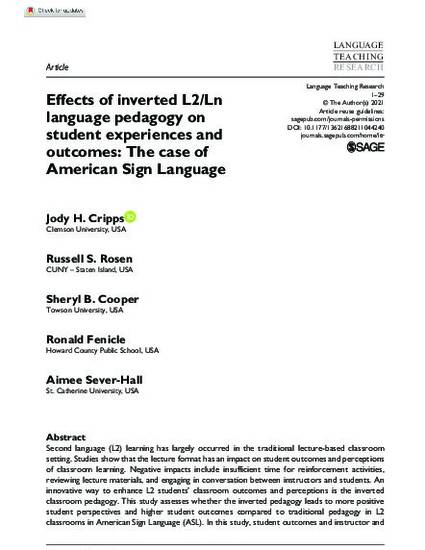
Article
Effects of Inverted L2/Ln Language Pedagogy on Student Experiences and Outcomes: The Case of American Sign Language
Language Teaching Research
(2021)
Abstract
Second language (L2) learning has largely occurred in the traditional lecture-based classroom setting. Studies show that the lecture format has an impact on student outcomes and perceptions of classroom learning. Negative impacts include insufficient time for reinforcement activities, reviewing lecture materials, and engaging in conversation between instructors and students. An innovative way to enhance L2 students’ classroom outcomes and perceptions is the inverted classroom pedagogy. This study assesses whether the inverted pedagogy leads to more positive student perspectives and higher student outcomes compared to traditional pedagogy in L2 classrooms in American Sign Language (ASL). In this study, student outcomes and instructor and student perceptions of inverted pedagogy for ASL are assessed using a mixed method design with one controlled (traditional) and one experimental (inverted) advanced ASL class in a postsecondary setting. Results suggest that the inverted pedagogy is an approach that is as viable as
the traditional approach for teaching and learning ASL as an L2 that enables students to engage in meaningful activities and conversations.
Keywords
- American Sign Language,
- Flipped Class Pedagogy,
- Instructor-students Interaction,
- Questionnaire and Survey,
- Second Language Learning
Disciplines
Publication Date
2021
DOI
10.1177/13621688211044240
Publisher Statement
SAGE
Citation Information
Jody H Cripps, Russell S Rosen and Sheryl B Cooper. "Effects of Inverted L2/Ln Language Pedagogy on Student Experiences and Outcomes: The Case of American Sign Language" Language Teaching Research (2021) p. 1 - 29 Available at: http://works.bepress.com/jody-cripps/10/
